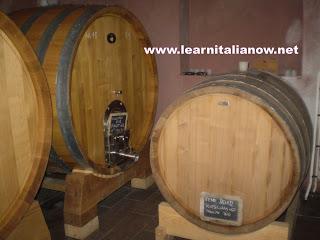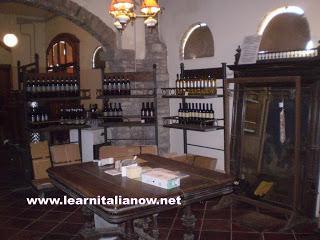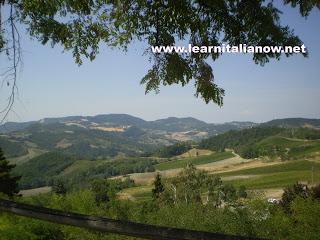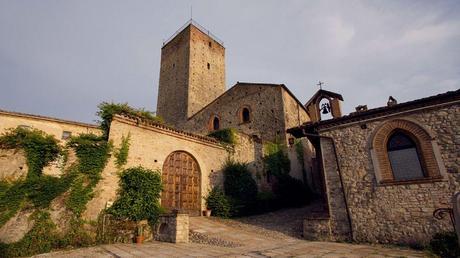
The cellar of the agritourism
In one my day trip I had arrived in the beautiful village of Fortunago (I invite you to read the post below because this village is very nice). http://www.learnitalianow.net/2013/08/a-virtual-walk-in-little-village-called.htmlNear this village, lost among the hills, we found a place that looked out of the world: the Castle of Stefanago( Fortunago province of Pavia). The castle is a private property and therefore can only be visited from outside. Near this castle there is an agritourism . As you well know an agritourism in Italy must produce some farming products. They product the wine… and such a quality wine! The owners have allowed us to visit their cellar. Their wine is biological - as they told us. They have explained me the difference between the normal production ant the biological one. In practice, instead of having huge plots of land with vineyards scattered, the land dedicated to the cultivation is much smaller and it is alternated with the meadows, the forests, the cultivation of cereals and wheat. The processing is absolutely handcrafted, this is why the wine produced is limited in quantities. All the production process is very accurate: I can assure you that the result is very remarkable even if the price is expensive. Moreover, if the production and the offer are limited, the price automatically increases (the average price for one bottle is 9 €). You can sit on the terrace overlooking the surrounding hills and taste the wines, eating some local cold cuts and a slice of cake.

the wine for cake and sbrissolona cake
It was a sunny day when I enjoyed that place . The friendly owners have explained me that some wines are stored in wooden barrels. Some types of wines are stored in acacia barrels to be more flavored. Not all wines, however, have this procedure. I particularly liked the rosé sparkling wine ( spumante) - among all the wines I have tasted there. The owners explained me that the spumante is made with the ancestral system : the sugar is not added because the harvested grapes are over-ripened and therefore they produces the natural sugars.I like a lot their pinot grigio . This wine is produced with the “uve tardive”.

The cellar of the agritourism
Obviously I’m completely unskilled so my question arose naturally: what are these” uve tradive”? Easy! Normally the harvest for the pinot is in August: if you want to produce a pinot with the uve tardive you have to harvest in September. The date of the grape harvest is not accidental but It depends from the ripening of the grapes and then from the climatic conditions that are essential for the entire process of the cultivation. The sugar is not added because - as in spumantino - the grapes have a natural dehydration. The grapes are put under stress (Also the grape can be stressed J) and they withdraw the fluids , for this reason they have a concentration of the natural sugars. Then the pinot is put in the acacia barrels and left for 15 to 18 months. Only after these months you can drink the final result and ….an incredible result!
The view from the terrace
I always like to discover these new aspects, they are so far away from my everyday life and but at the same time they are linked with our habits…the wine is always on our table…
Nelle mie scorribande in giro ero finita nel magnifico borgo di Fortunago ( vi invito a leggere il post sotto su questo borgo perchè è molto bello). Vicino a questo paese, sperduto fra i colli, abbiamo trovato un posto che sembrava fuori dal mondo: il Castello di Stefanago, Fortunago provincia di Pavia. Il castello è una proprietà privata e quindi visitabile solo dall’esterno. Nei pressi di questo castello c’è un agriturismo. Come ben sapete per essere agriturismo una struttura in Italia deve produrre qualche cosa i suo. Qui si fa il vino: e che vino!

Castello di Stefanago
I proprietari ci hanno accompagnato in una visita alla cantina. Il vino che producono, come ci raccontavano è biologico. Ho scoperto con loro la differenza. In pratica invece di avere appezzamenti enormi di terreno con vigne disseminate , il terreno dedicato alla coltivazione è molto più piccolo e si intervalla prati, boschi , coltivazione di cereali e frumento. La lavorazione è assolutamente artigianale per cui il vino verrà prodotto in quantitativi ridotti. La cura è tantissima: il risultato vi posso assicurare che è molto buono, il prezzo è caro. D'altronde se la produzione è limitata e l’offerta non è così ampia il prezzo automaticamente aumenta ( siamo comunque sulla media dei 9 euro a bottiglia). L’aspetto piacevole è potersi sedere sulla terrazza di fronte ai colli e assaggiare i vini accompagnano la degustazione con salumi e una bella fetta di torta. Una giornata di sole ha accompagnato la mia degustazione. Mi hanno spiegato i gentili proprietari, che alcuni vini sono conservati in botti di legno. Per aromatizzare maggiormente alcune tipologie di vino le botti scelte sono in acacia. Non tutti i vini hanno bisogno però della conservazione in botte. Fra quelli che ho assaggiato devo dirvi che mi è piaciuto particolarmente lo spumantino rosato. Mi è stato spiegato che la produzione è di tipo ancestrale senza aggiunta di zucchero perché l’uva che viene raccolta è in sovra maturazione e quindi produce degli zuccheri naturali. Altro vino che mi è piaciuto è il loro pinot grigio. Anche questo vino viene prodotto con uve tardive. Ovviamente da completa inesperta la mia domanda sorgeva spontanea: cosa sono queste uve tardive? Semplice! Normalmente la vendemmia per produrre il pinot è ad agosto, volendolo fare con uve mature sarà a settembre. Mi facevano notare che la data non è scelta a caso ma in base alla maturazione dell’uva nell’anno e quindi alle condizioni climatiche che dettano legge su tutto il processo della coltivazione. In questo vino non viene aggiunto lo zucchero perchè anche qui, come nello spumantino, si lavora l’uva facendo sì che ci sia un processo di disidratazione naturale. L’uva messa sotto stress ( avete visto anche l’uva può essere stressata J ) tende a ritirare i liquidi e avere una concentrazione di zuccheri naturali. A questo punto viene messa in botti si acacia e lasciata dai 15 ai 18 mesi. Solo allora potrete gustare il risultato finale: e che risultato!Mi piace sempre scoprire questi nuovi aspetti, sono così lontani dalla mi quotidianità eppure se ci pensate al contempo così vicini perché quel vino è sulla nostre tavole…

